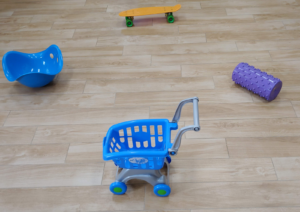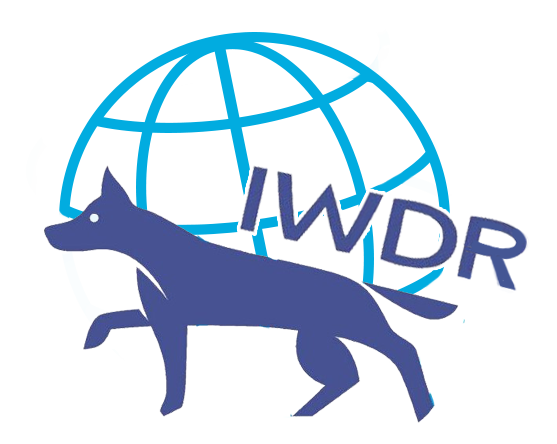Early Socialization - Week 5 - 28-35 Days
![]() TIP: Click the quick-links above to go directly to each section. You can also click the anchor icons at each section to return to the top of the page.
TIP: Click the quick-links above to go directly to each section. You can also click the anchor icons at each section to return to the top of the page.
Quick Reference Guide:
Goal:
Build puppy’s bond with humans through praise, petting and food; overcome new fear responses
Environments:
On site; such as outdoor play area, rooms near den
Volunteer Type:
Wide variety of demographics, for gentle handling
Introduction
This week, puppies will begin to show fear responses so it is important to provide puppies with positive experiences with environmental enrichment as well as interactive activities. During interactive activities, it is important for the puppy to focus on the handler bond and to associate this with positive rewards such as praise, petting, and food rewards.
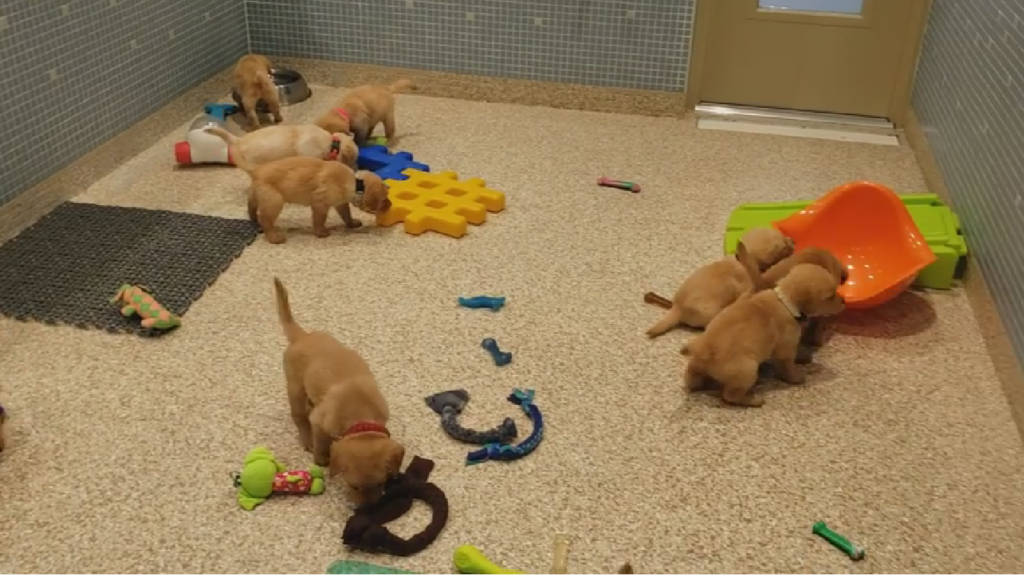
PUP IS IN THE ENGAGED (GREEN) ZONE most of the time OR PUP IS IN THE CONFLICTED (YELLOW ZONE) briefly then moves back into the green zone once it has resolved the internal conflict:
- Pups will happily explore the new environment
- Pups will play with littermates then fall asleep
- Pups will display no stress signals or if 1 or 2 stress signs (yawning, whinging) but pup quickly resolves inner conflict without escalating to additional stress signals.
- Second exposure pups are accepting of longer durations
- Addition of familiar surfaces, massage and textures accepted without issue.
Puppies are more susceptible to fear reactions beginning this week. Extra caution should be taken to focus on building positive experiences and exposures to build confidence.
Pups still need large amounts of sleep. Do not over stimulate the pup. It cannot learn in this mode
Observe pup and adjust procedure appropriately so it is a positive learning experience. Each pup is worked as an individual and techniques are for this pup not the whole litter.
Early repeat exposure in different environments will add to pup’s confidence and ways to resolve inner conflict.
Keep it brief: Remember pups have short attention spans. A successful exposure may be only seconds long and an entire education session should be no more than 5 minutes.
Keep your objective in mind: Since puppies have short attention spans, it is important to focus on the task at hand. While it is very tempting to snuggle a puppy before working with them, this can take away from the puppy’s purposeful learning for the day as they are able to work for noticeably short periods of time
Give the puppy an “escape route”: When an activity has gone on too long, is too overwhelming, or too challenging, a puppy needs a means to avoid it. If a puppy uses the escape route frequently, stop and seek assistance. Large objects, tunnels, gap behind crate can offer a pup a safe area to resolve their inner conflict.
During interactive activities, we continue to promote the puppy handler bond. Any time the pup choses to return its focus onto the handler reward this choice immediately with a smile, praise, petting or a food reward.
Mix up the rewards so puppy has variety and keeps interested and wanting to bond and work with us. Remember to use a reward that the puppy sees as reinforcing for it. Some Golden Retrievers are not as food oriented as say a Labrador Retriever. Should food not be a strong motivator try a soft fluffy toy or hard rubber toy. The pups focus should be on the handler so lots of rewards for good choices. The frequency of food rewards can become intermittent then phased out when the pup is older.
This week pups will learn that working with humans is fun and challenging.
Interactive activities are a way for us to expose puppies to new objects, sounds, surfaces and movement in the environments and to enable us to get feedback about how the pup responds. The information we collect helps give us to continue to build up a better picture of the puppy’s personality and how they cope with changes in environment, how inquisitive and confident they are and overall whether the puppy would be a good candidate as a guide or service dog.
Continue to promote remaining calm relaxed during body handling and massage as the building up of positive human relationships continues this week.
Items needed for Den this week – Variety is important to keep pups inquisitive and accepting of change
Toilet Box (To be used if needed by pups in between toilet breaks)
Ramp to concrete
Sound
Visuals
Surfaces
Movement
Random Object
Hanging Toys
Activity Box
Hard Chew Toys
Adaptability is an important skill in working dogs. Teaching pups to accept daily changes in environment, handling and routine during this age group will help them generalise to any environment in their working life.
Teaching pups to interact with their environment without overreacting is an important skill in producing sound working dogs.
Teaching these skills during the early critical learning period will produce better results than introducing it after 12 weeks of age when pup is not as adaptable to changes.
Increasing the pup’s repertoire of positive associations around new and novel objects and environments will result in resilient dogs.

Problem Solving
If a puppy has a significant change in energy and/or needs a longer time to recover, give the puppy time to resolve the conflict on their own. The handler can give the puppy support and encouragement with voice and soft petting. If the puppy has a severe change in energy and is no longer able to be engaged with the handler and activity, end the session on a positive note and return the puppy to their litter.
- Allow pup time to resolve inner conflict themselves
- Offer emotional support via voice and touch
- Shorten duration of visit. If one pup displays distress signs (whining) the others will usually follow. Be prepared to move when all pups are quiet so as not to reinforce a negative behaviour (whining gets what I want)
- Engage with pup using favourite toy
Encourage mom to come near the puppies and interact with the items. If puppies continue to show stress signs, return puppies to their den with Mom and try a shorter amount of time next time.
- Look at protocols used in handling.
- Are pups touched prior to being lifted off ground for weighing?
- Ensure all staff move pups slowly and absolutely no flying quickly through the air.
- Ensure that the massage is no longer than 1 minute. Reduce time then slowly build up again.
- Place another pup next to the pup being massaged for a familiar scent.
- Use a small piece of whelping mat that has been left under puppies. Familiar scent will be on the massage whelping mat.
Stop and place hands around pup’s chest area. Do some gentle circular motion with your hands. Once pup is calm again you can resume the body handling.
It can help to go back to an area on the body that pup is comfortable being handled and try again.
Should pup still not be comfortable reduce the session times then build up again.
Try luring with slower, more deliberate movements. Make sure you have pup’s interest in the lure and maintain that connection. Practice moving your arm with a “mixing bowl” movement – wide, sweeping and steady.
Passive Environmental Enrichment
Passive exposure continues by exposing pups to a variety of surfaces, sounds, movement, objects in their crate and den environment.
Acceptance of change and difference can be achieved by placing 1 random object into the nest each day that the puppies have not been exposed to before (backpack, hat, purse, statue like objects). Observe and record each pup’s reaction to novel object.
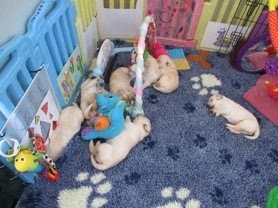
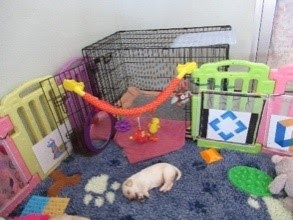
Note this video covers multiple age groups. Please see the section from 3:08 – 5:13 for content appropriate for this age group.
Working dogs encounter a variety of sounds throughout their career. Some dogs may travel with their partner through busy cities while others may go to the Opera or loud concerts with their partner. With all of the different sounds a dog may encounter, we want our puppies to be comfortable and confident with many different sounds during their critical socialization period. During this week, we will focus on positive interactions with different sounds.
At this age, environmental sound CDs and music can be played quietly on a radio or computer in the same room as the puppies for an hour per day.
Hand-held sounds items as well as interactive sound objects can be used during this activity. Below are age-appropriate examples for both hand-held objects as well as other sound items that puppies can interact directly with.
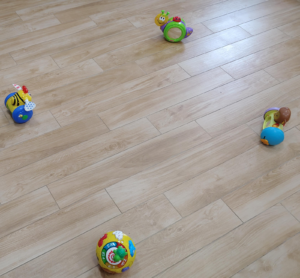
Goal: To allow puppies to explore multiple sound objects with a handler and to be comfortable with a variety of sounds.
To prepare the designated space for this curriculum, please complete the following steps.
- Gather 5 noise objects and 2 handheld noise objects. Remember variety when selecting objects.
- Place the handheld noise objects on a nearby counter or out of puppies’ reach.
- Arrange the objects in a circle spread apart enough for the puppies and handler to move around comfortably.
You are now ready to retrieve the litter of puppies you are working with.
- Allow the puppies to explore the room upon entering for up to 30 seconds.
- Use the hand-held noise objects when the puppies are playing and exploring the room.
- Encourage the puppies to explore each of the objects with you.
4. Continue around the circle in the same manner
It is important for working dogs to be comfortable with walking over different types of surfaces such as grates and uneven pavements. Puppies learn quickly that walking over bumpy and open surfaces is completely normal.
It is important to have a variety of surfaces for the puppies to walk on so they do not grow accustomed to only walking over one particular surface. When selecting equipment, think of having different textures and materials.
More challenging surfaces can be added in the litter’s room to encourage them to climb and walk over different surfaces. This helps build the puppy’s confidence and also their muscles! Keep in mind that the surfaces need to be age and skill appropriate.
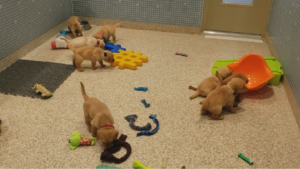
Goal: For the puppies to confidently explore each surface with a handler.
- Choose a variety of 5 surfaces. Items can be different heights, just be mindful of the puppy’s height, do not make it unsafe for the puppy.
- Arrange the items in a circle with enough distance for the puppies to walk comfortably around each item.
You are now ready to retrieve the litter of puppies you are working with.
- Allow the puppies to explore the room upon entering for up to 30 seconds.
- Encourage the puppies to climb on or walk over all of the surfaces.
3. Continue around the circle in the same manner.
Working dogs must be accepting of a variety of novel objects they may encounter in the community; so, it is important that at an early age they begin to build their reference library of unusual items, including those that move, so that they are comfortable and confident with different novel objects.
Working dogs must be accepting of a variety of novel objects they may encounter in the community; so, it is important that at an early age they begin to build their reference library of unusual items, including those that move, so that they are comfortable and confident with different novel objects.
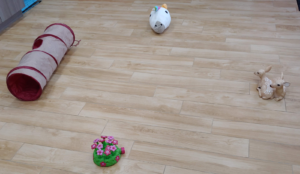
Novel Objects Protocol
Goal: To allow puppies to explore multiple novel objects with a handler and to be comfortable with novel objects.
To prepare your designated space for this activity, please complete the following steps.
- Gather 5 novel objects. Remember variety when selecting objects.
- Arrange the objects in a circle spread apart enough for the puppies and handler to move around comfortably.
You are now ready to retrieve the litter of puppies you are working with.
- Allow the puppies to explore the room upon entering for up to 30 seconds.
- Encourage the puppies to explore each of the objects with you.
- Continue around the circle in the same manner.
Safe items that move can be placed in the litter’s room to allow puppies to explore on their own.
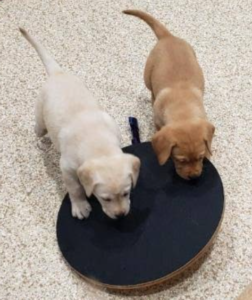
Working dogs need to be comfortable walking on unstable objects and comfortable with objects that move. It is important that puppies learn to be confident with walking on unstable objects and with moving objects.
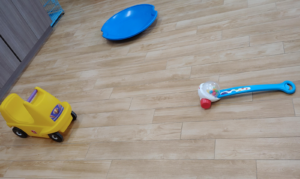
Goal: To allow puppies to explore multiple motion objects with a handler and to be comfortable with walking on unstable objects and moving objects.
To prepare the designated space for this activity, please complete the following steps.
- Gather 4-5 motion objects. Remember variety when selecting objects.
- Arrange the objects in a circle spread apart enough for the puppies and handler to move around comfortably.
You are now ready to retrieve the litter of puppies you are working with.
- Allow the puppies to explore the room upon entering for up to 30 seconds.
- Encourage the puppies to explore each of the objects with you.
- Continue around the circle in the same manner.
Ensure you introduce a large variety of new people, start gradually to build up pup’s acceptance of difference. Demographics to cover include; young, elderly, male, female, toddlers, different ethnic groups
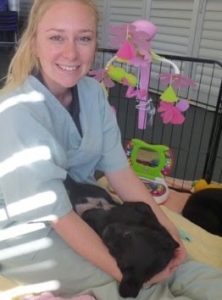
Passive open crate exposure is the foundation to crate training. Puppies can explore the crate and go in and out as they wish. Hard plastic crates can be used if the front door is taken off to prevent puppies from becoming stuck in the crate.
Also make sure that latch is fastened back if using a metal crate.
Soft bedding and interactive toys will help to promote positive associations around the crate.
You can review further information on crate settling here.
Also, make sure to consider Biosecurity if your crate is positioned around other dogs, or outside of the puppy pen, etc.
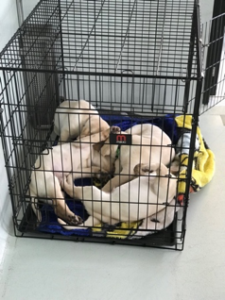
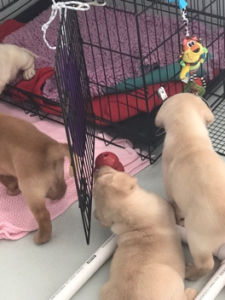
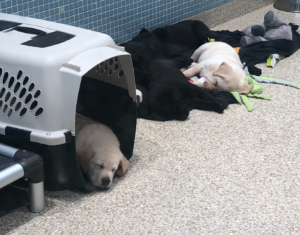
Puppies can now begin to get used to settling inside a closed crate. You can review further information on crate settling here.
Some tips:
- Soft bedding and interactive toys will help to promote positive associations around the crate. Make sure to supervise puppies with bedding in case they chew it. If the puppy chews bedding, remove it for the safety of the pup and make sure you provide appropriate chew toys while the pup is in the crate.
- Pup should spend time in a crate away from their littermates but around people. Puppies need to learn to settle in their crates while people are around, as this will prepare them for crate time in their raiser’s home.
- Offer the pup a stuffed Kong or nylabone.
- Start off slowly to build positive associations: gradually increase time in crate from 5 min to 30 mins. Make sure to toilet the pup before and after.
Interactive Activities
- Purposeful play with littermates exploring novel objects, sound objects, motion objects, and surfaces
- Puppies will develop positive experiences with body handling
- Puppies build positive associations with new objects and sounds
- Puppies build handler engagement
experiences around body handling, and puppies can build positive association with new objects and sounds. Every interaction with the puppies continues the building of handler engagement.
It is important to start to build a solid foundation of skills. Body Handing is ongoing and involves lots of practice. It can be done in short sessions throughout the day in order to set the pup up for success by keeping skill training fun and expectations consistent. Body handling is the process of teaching our puppies to accept all parts of their body being handled while remaining calm while we touch and move all parts of their body.
This is beneficial for health/Vet visits. These skills also help with body sensitivities to equipment the pup may need to wear such as boots or coat.
Remember, Body handling should be a calm, gentle process – it’s not a time for cuddles or play – that can come later! Take extra care around your pup’s teeth, ears and paws – these areas are crucial for Body Handling but many pups find the handling of these areas strange at first.
Start by Teaching the “Close” position:
- Start by crouching on the ground with the puppy in front of you, facing you.
- Place your right knee on the ground – If pup is on a lead put the lead under your knee so both hands are free 3. Use your left hand to lure the pup from your right knee in a circle until they are between your legs facing away from you
- Tilt your lure back over the pup’s head so they go into a sit
- Mark and pay
- Put your knee down so you are kneeling with pup sitting between your legs and place your two hands on the pup’s chest
- Repeat steps 1-6 until pup is quickly and easily moving into position as you lure
- Repeat steps 1-6 but this time say the word “close” just as their bottom touches the ground Do this 3 times 9. Fade the lure and work on duration – Reward pup for being still and calm. Ignore any wriggling or mouthing.
- Do this 3 times
- Fade the lure and work on duration – Reward pup for being still and calm. Ignore any wriggling or mouthing.
Handling Method
NOTE: For pups over 3 weeks, all handling starts in the “Close” position.
Ears
- Gently hold the puppy’s chin with one hand then use the other hand to lift their ear
- Look inside and smell their ear for any signs of infection
- Repeat with the other ear
- Gentle praise, reward
Eyes
- Hold puppy’s chin gently and look at each eye
- Gentle praise, reward
Teeth
- Gently hold pup’s chin and use the other hand to lift pup’s chin on one side to look at their teeth
- Repeat on the other side
- Gentle praise, reward
Legs and paws
- Run your hand down one of pup’s legs to their paw
- Feel between the pads on their paw
- Gentle praise, reward
- Repeat with other 3 paws
Vet Restraint
- Use your left hand to gently restrain pup’s head against your chest so they are looking towards your left
- Run your right hand down the back of the pup’s right leg to their elbow then raise their leg (it should be outstretched as if for a blood draw)
- Mark and pay
- Switch so pup is facing the opposite way and the other leg is outstretched
- Gentle praise, reward
Lay Over
- Place one arm underneath pup’s front legs
- Lift your arm (therefore lifting the pup’s front legs)
- Lean down until you are lying over the top of the dog
- Remove your hand from under the pup
- Gentle praise, reward
Release cue
- Tell the puppy “Go free” and allow them to break position
- Give them a pat and plenty of praise
Handler can throughout the day not engage with pup but still provide variety by
- Knocking on the door when passing the den.
- Make other random sounds throughout the day e.g. when going in den for other duties like health checks, weighing pups, changing bedding
- Rattle hanging toys, bang two objects together to make an unexpected noise, drop objects, pretend to cough, laugh or sneeze.
The handler can take pup outside of the den for one on one time away from the littermate. Again, a very brief experience will aid new learning and build confidence and resilience. Return pup to Brood for a comfort feed.
Only extend time away from littermates once pups are comfortable and have confidence in the handler. Pups are learning the handler will not ask pup to do more than it is capable of doing. Building trust between handler and pup is ongoing.
Please Note: If at any time the health or safety of the puppy is at risk (i.e., the puppy is eating something they aren’t supposed to, or the puppy has escaped the yard) please disregard this protocol and immediately address the concern.
Goal: To associate the cue “Puppy, Puppy” with being fed and to use this cue to call the puppies to you.
When to do the activity:
Before feeding the puppies
After you enter the kennel, tap the bowls, and say “Puppy, Puppy” before putting the bowls down. This conditions the puppy to associate being fed after the bowls are tapped together and they hear “Puppy, Puppy”.
Bringing the puppies in from the yard
Materials needed: Treat pouch with the litter’s food
When you are ready to leave the yard, say “Puppy, Puppy” to and give each puppy a treat. Exit the yard and encourage the puppies to follow you into the concrete walkway. When you are halfway to their kennel, give the puppies a treat and reward them for their hard work.
Use the cue “Puppy, Puppy” to bring the puppies in to their outside kennel. Say “Puppy, Puppy” and encourage the puppies to follow you. Give the puppies a treat when they come into their back kennel.
Troubleshooting:
The puppies won’t come to you or follow you out of the yard
- Decrease the distance between you and the puppies in the yard. Cue the puppy by saying “Puppy, Puppy” and treat them when they come to you.
Have Brood in with pups (ensure Brood knows and is comfortable with onlookers)
Short visits initially and end on a positive before pup displays stress signals
Repeat a second time for confidence building. Pup has been there so building up more positive associations around changing environments
Use bedding that has the pups/Brood scent on it
Bring familiar toys
No new people in with pups. Staff are a familiar like toys and blankets. Limit new learning to sights, smells, sounds in new environment.
Goal: To establish a bond between puppy and handler and to teach puppies that following the handler is a fun and rewarding experience.
Connecting with puppy: It is important to connect with the puppy before starting any activity. This involves letting the puppy know that you are super fun and it is fun to follow you.
How to Begin Follow Me
Step 1: “Let’s Go”
Prerequisite: Connection made
- Begin in a familiar area with few distractions – a quiet hallway for example. Say “Let’s Go” and start walking forward from your pup.
- When the pup catches up with you, throw a puppy party!
- A puppy party is a prolonged period (5 or more seconds) of verbal praise, happy/excited body language by the handler, and high value rewards (given one at a time). A party is used to tell the dog, “Wow! That was awesome! You are a genius!” It’s used to emphasize breakthroughs or exceptional efforts by the dog, and to reward difficult choices (usually in distracting situations).
- Say “Let’s Go” again moving away from your pup once more.
- When pup joins you throw another puppy party.
- In the early stages of Follow Me you may be hosting frequent puppy parties, but as the pup’s understanding progresses, you will reserve parties for the next level of exceptional efforts.
Step 2: “This Way”
Prerequisite: Directional change, Connection is still solid when moving
- Find an area where you can easily change direction.
- Say, “Let’s Go” and walk forward away from your pup.
- As the pup naturally moves in your direction, say “This Way” and change direction.
- As pup follows your change in direction immediately throw a puppy party.
- Say,”Let’s Go” and move away again from your pup.
- As the pup naturally moves in your direction, say “This Way” then change direction again. As the pup follows your change in direction, immediately throw another puppy party.
Step 3: Increasing the distance and directional changes
Prerequisite: Connection remains intact with directional changes
- Stay in a familiar area when you begin increasing the distance and increasing directional changes.
- As in previous steps, say “Let’s Go” and move away from your pup increasing your distance. Remember to stop and praise the pup often for choosing to follow you.
- Be unpredictable. Don’t stop in the same spot and be sure to change direction and the number of steps you take. You want the pup to think “I really have to pay attention to the person.”
What Successful Follow Me Looks Like
- Pup starts off attentive to you and chooses to follow you without any coaxing or luring.
- You reward the pup’s voluntary decision to follow.
- Pup follows you and works to keep up with you even when you turn, change your pace and eventually in the presence of distractions.
- Pup may briefly stop and investigate something then quickly catches up with you.
Problem Solving
- If the pup stops following STOP AND SILENTLY WAIT for the pup to “rediscover” you. When the pup reconnects, praise and throw a really big “puppy party.”
- If the pup seems to have completely forgotten you, return to the pup and reconnect (Step 1) reminding the pup that you are super fun to be with.
- If connection is lost you may need to pick the pup up and move to a less distracting area and reconnect. If Pup passes you, test the connection by saying “This way!” and change your direction. If the pup follows you throw a puppy party. If the pup doesn’t follow then STOP AND SILENTLY WAIT for the pup to “rediscover” you. When the pup reconnects, praise and throw a puppy party. If pup still hasn’t responded, you will need to go back to “Making the Connection”.
- Avoid the nagging trap. Repeating the pup’s name or calling the pup to you may result in the pup tuning you out as well as diminishing the importance of the pup’s name. All you need to say is “Let’s Go” or “This Way.”
- If you are repeating the pup’s name or calling the pup to you, then you have lost the connection and you need to go back to “Making the Connection”
Key Points
- Follow Me is not only about the pup being connected. It is also about the person being connected. You need to be aware of the pup’s location and his mental state at all times.
- Developing a solid connection will help you and the pup during socialization experiences. The pup learns that wherever he goes he will understand that it is his responsibility to keep track of his partner. Short sessions + frequent practice = success: Practice in different locations inside and outside with few distractions.
- With frequent practice, your connection strengthens and the better you begin to work as a team. Establish a connection before saying, “Let’s Go” then leaving.
- Change your speed and direction saying, “This way” so pup knows you are turning, and then turn. Be unpredictable. Frequent changes in direction and speed keep the pup from anticipating your next move.
Introduce pups to the room prior to placing it in hydrobath.
No water initially. Non slip mat on floor
Pups in pairs
Familiar toys for play
Voice and touch for reassurance
Time ending so it is a short brief positive experience
Toggle Content
Goal: To allow each puppy to explore multiple sound objects with a handler and to be comfortable with a variety of sounds.
To prepare the designated space for this curriculum, please complete the following steps.
- Gather 4-5 noise objects and 2 handheld noise objects. Remember variety when selecting objects.
- Place the handheld noise objects on a nearby counter or out of the puppy’s reach.
- Arrange the objects in a circle spread apart enough for the puppy and handler to move around comfortably.
You are now ready to retrieve the first puppy you are working with.
- Allow the puppy to explore the room upon entering for up to 30 seconds.
- Use the hand-held noise objects when the puppy is playing and exploring the room.
- Encourage the puppy to explore each of the objects with you. Reward the puppy with praise, petting, and food rewards.
4. Continue around the circle in the same manner.
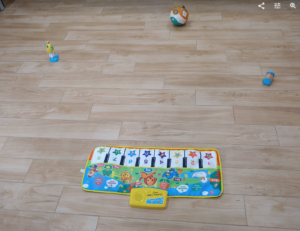
Protocol
Goal: To allow the puppy to explore multiple novel objects with a handler and to be comfortable with novel objects.
To prepare your designated space for this activity, please complete the following steps.
- Gather 4-5 novel objects. Remember variety when selecting objects.
- Arrange the objects in a circle spread apart enough for the puppy and handler to move around comfortably.
You are now ready to retrieve the first puppy you are working with.
- Allow the puppy to explore the room upon entering for up to 30 seconds.
- Encourage the puppy to explore each of the objects with you. Reward the puppy with praise, petting, and food rewards.
- Continue around the circle in the same manner.
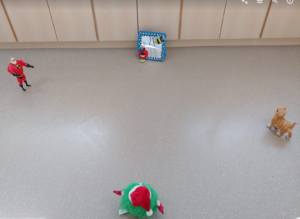
Protocol
Goal: For the puppy to confidently explore each surface with a handler.
- Choose a variety of 4-5 surfaces. Items can be different heights, just be mindful of the puppy’s height, do not make it unsafe for the puppy.
- Arrange the items in a circle with enough distance for the puppy to walk comfortably around each item.
You are now ready to retrieve the first puppy you are working with.
- Allow the puppy to explore the room upon entering for up to 30 seconds.
- Encourage the puppy to climb on or walk over all of the surfaces. Reward the puppy with praise, petting, and food rewards.
3. Continue around the circle in the same manner.
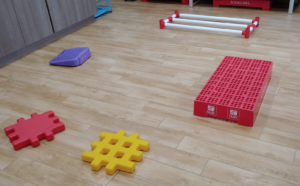
Goal: To allow the puppy to explore multiple motion objects with a handler and to be comfortable with walking on unstable objects and moving objects.
To prepare the designated space for this activity, please complete the following steps.
- Gather 4-5 motion objects. Remember variety when selecting objects.
- Arrange the objects in a circle spread apart enough for the puppies and handler to move around comfortably.
You are now ready to retrieve the first puppy you are working with.
- Allow the puppies to explore the room upon entering for up to 30 seconds.
- Encourage the puppies to explore each of the objects with you. Make sure to create positive experiences for the puppy by pushing movable objects away from the puppy. Reward the puppy with praise, petting, and food rewards.
- Continue around the circle in the same manner.
